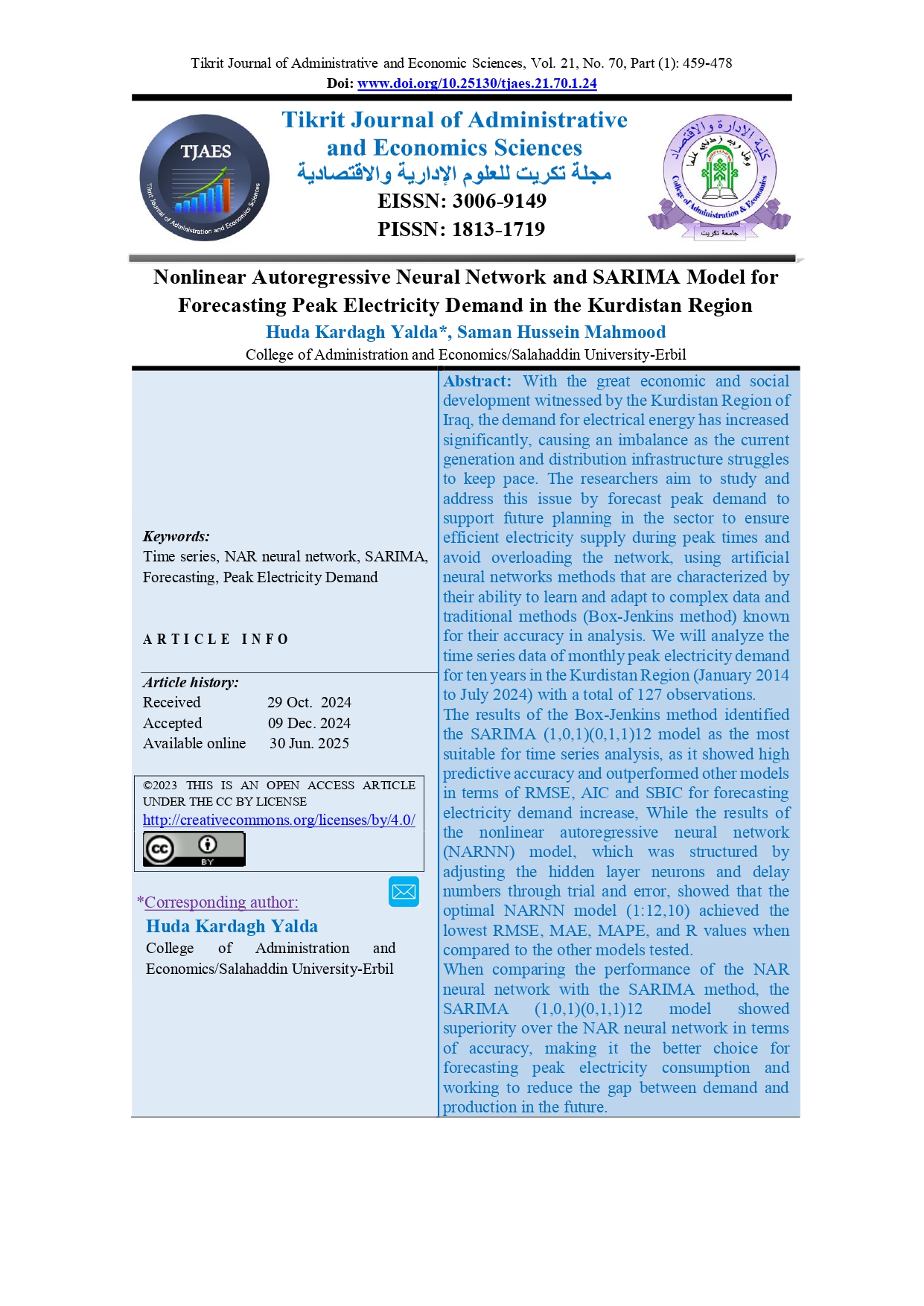Nonlinear Autoregressive Neural Network and SARIMA Model for Forecasting Peak Electricity Demand in the Kurdistan Region
Main Article Content
Abstract
With the great economic and social development witnessed by the Kurdistan Region of Iraq, the demand for electrical energy has increased significantly, causing an imbalance as the current generation and distribution infrastructure struggles to keep pace. The researchers aim to study and address this issue by forecast peak demand to support future planning in the sector to ensure efficient electricity supply during peak times and avoid overloading the network, using artificial neural networks methods that are characterized by their ability to learn and adapt to complex data and traditional methods (Box-Jenkins method) known for their accuracy in analysis. We will analyze the time series data of monthly peak electricity demand for ten years in the Kurdistan Region (January 2014 to July 2024) with a total of 127 observations.
The results of the Box-Jenkins method identified the SARIMA (1,0,1)(0,1,1)12 model as the most suitable for time series analysis, as it showed high predictive accuracy and outperformed other models in terms of RMSE, AIC and SBIC for forecasting electricity demand increase, While the results of the nonlinear autoregressive neural network (NARNN) model, which was structured by adjusting the hidden layer neurons and delay numbers through trial and error, showed that the optimal NARNN model (1:12,10) achieved the lowest RMSE, MAE, MAPE, and R values when compared to the other models tested.
When comparing the performance of the NAR neural network with the SARIMA method, the SARIMA (1,0,1)(0,1,1)12 model showed superiority over the NAR neural network in terms of accuracy, making it the better choice for forecasting peak electricity consumption and working to reduce the gap between demand and production in the future.
Downloads
Article Details
References
Bishop, C. M. (1995). Neural Networks for Pattern Recognition. UK: Clarendon Press.
Brockwell, P. J., & Davis, R. A. (2002). Introduction to time series and forecasting. New York: NY: Springer New York.
Ahmed, M. M., & Mahmood, S. H. (2023). Building SARIMA Models to Analysis and Forecast Time Series Data of Road Traffic Accidents in the Kurdistan Region of Iraq. Zanco Journal of Human Sciences, 27(1), 382-393.
Ali, T. H., Mahmood, S. H., & Wahdi, A. S. (2022). Using Proposed Hybrid method for neural networks and wavelet to estimate time series model. Tikrit Journal of Administrative and Economic Sciences, 18(57), 432- 448.
Allende, H., Moraga, C., & Salas, R. (2002). Artificial neural networks in time series forecasting: A comparative analysis. Kybernetika, 38(6), 685-707.
Benrhmach, G., Namir, K., Namir, A., & Bouyaghroumni, J. (2020). Nonlinear Autoregressive Neural Network and Extended Kalman Filters for Prediction of Financial Time Series. Journal of Applied Mathematics, 1-6.
Box, G. E., Jenkins, G. M., Reinsel, G. C., & Ljung, G. M. (2015). Time series analysis: forecasting and control. New York: John Wiley & Sons.
Fausett, L. V. (1994). Fundamentals of Neural Networks: Architectures, Algorithms, and Applications. New York: Prentice-Hall.
Galushkin, A. I. (2007). Neural Networks Theory. New York: Springer.
Kadir, D. (2020). Time Series Modeling to Forecast on Consuming Electricity:A case study Analysis of electrical consumption in Erbil City from 2014 to2018. Journal of Al-Rafidain University College For Sciences (Print ISSN: 1681-6870), 1, pp 472-485.
Koenecke, A. (2020). Applying deep neural networks to financial time series forecasting. Stanford, California, USA: Institute for Computational & Mathematical Engineering.
Mahmood, S. H. (2016). Using Artificial Neural Network Model with Time Series Monthly Average Electricity Demand in Kurdistan Region. Using Artificial Neural Network Model with Time Series Monthly Average Electricity Demand in Kurdistan Region, 20(6), 421-432.
Mahmood, S. H., & Ahmed, M. M. (2023). Application of Elman Neural Network and SARIMA Model to Modeling Road Traffic Accident in the Kurdistan Region of Iraq. Iraqi Journal of Statistical Sciences, 20(2), 43-56.
Ratur, R., & Sargsyan, H. (2018). A Nonlinear Autoregressive Scheme for Time Series Prediction via Artificial Neural Networks. Journal of Computer and Communications, 6(9), 14-23.
Sarhan, H. A. (2018). Using some statistical methods to predict the lost electrical energy (applied Study). karbala: University of KaralaIra.
Shumway, R. H., & Stoffer, D. S. (2006). Time series analysis and its applications. New York : Springer.
Taherdangkoo, R., Tatomir, A., Taherdangkoo, M., Qiu, P., & Sauter, M. (2020). Nonlinear Autoregressive Neural Networks to Predict Hydraulic Fracturing Fluid Leakage into Shallow Groundwater. water, 12(3), 1-14.
Tsay, R. S. (2005). Analysis of financial time series. Hoboken, New Jersey: John Wiley & sons.
Yaffee, R. A., & Mcgee, M. (2000). An introduction to time series analysis and forecasting: with applications of SAS and SPSS. USA: Academic Press.
Zhang, G. P. (2003). Time series forecasting using a hybrid ARIMA and neural netwotk model. Neurocomputing, 50, pp 159-175.
Zhang, G. P., & Qi, M. (2005). Neural network forecasting for seasonal and trend time series. European journal of operational research, 160(2), 501-514.


